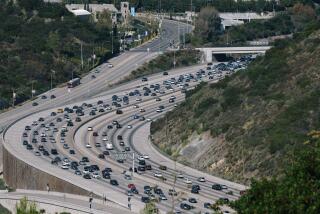Simply Put, Territorial Rating Is Redlining : Auto Insurance: Out of greed, the industry would rather hang on to a racist policy than comply with Prop. 103.
The current debate on insurance ratings is marked by indecision, but one thing does seem regrettably certain: territorial rating.
For years, the term territorial rating has been employed by the insurance industry to describe the practice of basing the price of insurance on the address of the insured. The industry prefers to use the euphemism of territorial rating for this practice to guard against charges of racial injustice. Simply put, territorial rating is redlining.
It is a practice in which a red line is drawn around certain areas (often using zip codes) that results in automatically higher rates for residents. People of color, who typically have lower incomes, usually predominate in redlined communities. Insurers have reason to be defensive: Redlining, no matter what it’s called, is racist.
State Insurance Commissioner Roxani Gillespie recently barred the use of territorial rating in setting the cost of auto insurance. At long last, we thought, she was implementing a critical provision of Proposition 103. This fleeting fantasy of fairness was later snatched from expectant consumers when the commissioner began to reconsider her uncharacteristic pro-consumer stance in the name of fairness--”a fair rate of return” for insurers.
What about fairness for folks who paid $1,050 in Compton (predominantly African American and Latino) for a 1981 Buick with basic liability coverage? Compare that to the residents of Torrance (four miles away and predominantly Anglo) who, with the same car and driving record, paid $550 (according to 1986 data supplied by the California Insurance Commission).
Further, the impact of price disparities has been multiplied by the state’s mandatory auto insurance law. For residents of redlined communities, the choice is grim: Pay excessive, discriminatory rates or break the law. Given the rates charged in those areas, it can come down to a choice between auto insurance and rent.
Insurers insist that territorial rating is necessary to the rate-setting process as an accurate predictor of “risk of loss.” Wrong. According to the Stanford Research Institute study of insurance rating factors, (a survey commissioned and paid for by the insurance industry) there is only a 7% correlation between where people live and their risk of loss. This refuted the insurers’ theory that in certain areas, accidents are inherently more likely to occur.
Having posted faulty assumptions, their logic goes on to place the burden of the loss not on those who drive in those “risky” areas, but on those who live in them. Until recently, this argument was blindly accepted, even by the commissioner, illustrating once again the manipulation of language and logic by this all-too-powerful industry.
Rather than set rates on individual driving records, the burden is imposed on entire communities. Neatly, but powerfully, packed into this policy is the stereotypical notion that people of color are generally less responsible and often more dangerous. So, then, the communities they occupy must be dangerous areas or at least unsafe for driving as well as other things. In the mind of insurers, risky driving conditions warrant the red line, as they seek to justify “the bottom line.”
Even more enraging is the fact that redlining has resulted in consumers in the affected areas subsidizing those whose communities are not redlined. Insurers insist that if they are “forced” to set rates equitably, rates will go up everywhere. But the only reason rates would go up is because insurers would raise them and the commissioner would approve them.
Although the California Supreme Court has guaranteed insurance companies the right to a “fair return,” they have not been guaranteed the right to limitless profits. These brazen insurers, however, care little about the effect on those who are least able to pay. Some have opposed any restrictions on territorial rating. Clearly, the insurance industry is hell bent on maximizing profits.
The law, as established by the people’s Proposition 103 victory, is clear. Rates should be based on three factors: the insured’s driving record; the number of miles driven annually, and the number of years of driving experience.
Unfortunately, Proposition 103 has a giant loophole, one in which the commissioner, guided by the industry, appears to be preparing to recklessly drive a Mack truck through. That loophole declares that the commissioner may approve the use of other rating factors if they have a substantial relationship to risk of loss. At first glance, that language seems to provide consumer protection, since it requires proof of a substantial relationship to risk of loss and must be approved by the commissioner. But it now looks as though the commissioner and certain consumer groups may compromise with the bullying insurance industry. Those who can least afford exorbitant rates would be required to suffer redlining in exchange for a short-term blanket freeze on premium increases.
Those of us who believe in civil and economic rights are used to tough struggles. On redlining, we are unrelenting: We will continue to insist that the rights of all insurance consumers be represented by appointed and elected officials. And we will continue to challenge unjust and unfair policies and practices wherever they are used, no matter what they are called.
More to Read
Sign up for Essential California
The most important California stories and recommendations in your inbox every morning.
You may occasionally receive promotional content from the Los Angeles Times.










